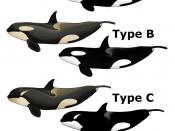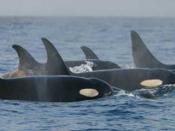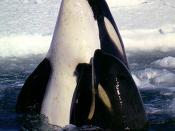Killer whales, next to humans, are the most widely distributed mammals. Killer whales live in all oceans of the world, however are plentiful in the Arctic, the Antarctic, and areas of cold-water upwelling. Time to time, they can be found along the shores of Washington, Vancouver, Oregon, California, Baja California, along the eastern coast of the United States not to mention the Resurrection Bay, Kachemak Bay, San Juan Islands, and Orcas Island.
In addition killer whales also have been seen in warm water areas such as Hawaii, Australia, Galapagos Islands, Bahamas, and the Gulf of Mexico. These sightings are rare, but they do show the killer whales' ability to venture around. Even more surprising is that the killer whales have been seen in fresh water rivers around the world! Places such as the Rhine, the Thames, and the Elbe. One even traveled 177 km up the Columbia River to eat fish! Although killer whales can be found in both the open ocean and coastal waters, they primarily inhabit the continental shelf in waters less than 200 m (656 ft.)
deep. Currents such as the Alaska Current (in the region of Vancouver), and the Gulf Stream (the coast of eastern United States) are warm currents. The western part the United States is mainly made up of cold currents as well as the artic and Antarctic currents. In coldwater areas, the distributions of these Orcas whales are limited by seasonal pack ice.
In some areas, the seasonal movements of killer whales are influenced by the migration of fish and other prey. In eastern Canada, killer whale movements are often a response to seal and rorqual whale migrations, while northeastern Atlantic killer whales seem to follow herring. In the Bering, Chukchi, and Beaufort seas, killer whales make considerable seasonal movements in response...


